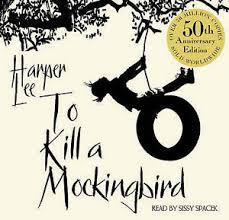From the very first lines this book is like: BOOM.
Really, great books are a miracle. They have such a sense of inevitability about them – as if they had to exist, and exist in exactly this way – that its hard to imagine that someone actually had to sit down and right them. Particularly interesting is the fact that this was Harper Lee’s first book. She was at work on a second one, and when this was accepted by an agent she apparently somehow froze on the second; and then when this turned into a major success (and success is putting it mildly – it’s possibly the best selling book of the 20th century) then it was really all over for her. She didn’t publish anything else for fifty years. The dreaded second album problem on steroids.
Anyway, this first album is more than most people manage in a lifetime. It tells the story of the children of a small town lawyer in Alabama who runs into trouble with his neighbours when he defends a black man against the charge of raping a white woman. The man is clearly innocent, but he is found guilty in any case. This sounds like it must be a serious story of discrimination, which it is, but at the same time it is a comic story of growing up, and a portrait of a small town that is both loving and damning.
What I most enjoyed was the subtly comic tone. When I really like a book, I tend to overquote on my blog. Here we go:
Maycomb was an old town, but it was a tired old town when I first knew it. In rainy weather the streets turned to red slop; grass grew on the sidewalks, the courthouse sagged in the square. Somehow, it was hotter then: a black dog suffered on a summer’s day; bony mules hitched to Hoover carts flicked flied in the sweltering shade of the live oaks on the square. Men’s stiff collars wilted by nine in the morning. Ladies bathed before noon, after their three-o’clock naps, and by night fall were like soft teacakes with frostings of sweat and sweet talcum
Teacakes with frostings of sweat and sweet talcum! I will never look at perspiring women the same way again. And here’s the family doctor who “had brought Jem and me into the world, had led us through every childhood disease known to man including the time Jem fell out of the tree house, and he had never lost our friendship. Dr. Reynolds said that if we were boil-prone things would have been different”
The children are a girl, Scout, and a boy, Jem. Here is Jem telling Scout to not get so angry at her aunt, as it bothers their father (who they call by his first name, Atticus):
“You know she’s not used to girls,” said Jem, “leastways, not girls like you. She’s trying to make you a lady. Can’t you take up sewin’ or somethin’?” “Hell no. She doesn’t like me, that’s all there is to it, and I don’t care. It was her callin’ Walter Cunningham trash that got me goin’, Jem, not what she said about being a problem to Atticus. We got that all straight one time, I asked him if I was a problem and he said not much of one, at most one that he could always figure out, and not to worry my head a second about botherin’ him.
Enjoyable piece of literary trivia: the character Dill in the book, who is Scout’s best friend, was based on Truman Capote, who in real life was Harper Lee’s next door neighbour in childhood. Monroeville Alabama great novelist per capita numbers are way high

